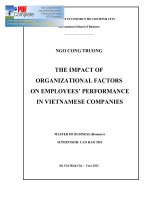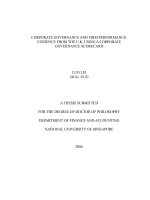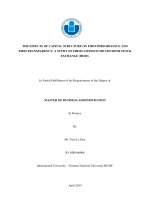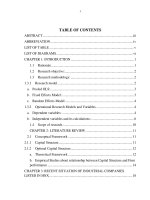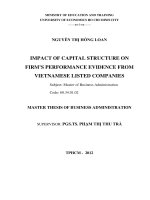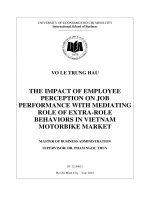The impact of corporate governance on firm performance evidence from vietnam
Bạn đang xem bản rút gọn của tài liệu. Xem và tải ngay bản đầy đủ của tài liệu tại đây (245.91 KB, 11 trang )
Economics and Business Letters
The impact of corporate governance on firm performance: Evidence from Vietnam
Nguyen Thi Dieu Chi Vu Thi Cam Hanh Cao Viet Hoang Duong Tien Thai Nguyen Thi Phuong Thao
Vu Thi Thanh Xuan
National Economics University, Vietnam
Abstract
This study investigates the impacts of corporate governance on firm’s performance evidence of Vietnam. We
use factors such as Board size, State ownership, Non-duality, Capital expenditure to total assets ratio, Operating
cash flow, Natural logarithm of total assets, Net sales growth, Asset growth rate and Leverage. We enhance
our analysis using non-linear multiple regression analysis. It bases on 825 observations of 75 companies that
specializing in trading consumer goods for the period 2007 to 2018. We find that differences in size amongst
firms may lead to differences in firm performance as firm size is correlated with firm operating environment,
source of organizational costs diversification of business and information asymmetry.
Keywords: consumer goods, corporate governance, firm performance.
JEL Classification codes: G34
1. Introduction
Corporate governance plays as an important role in every company. As far as we know, there are many different
models analyzing the corporate governance around the world. They are differentiated by the variety of
capitalism in their country. For example, the Anglo-Saxon countries are likely to maximize the interests of
shareholders, while the multi-stakeholder model, normally conducted in Continental Europe or Japan also
mentioned the interests of workers, managers, suppliers, customers and the community (Allen & Gale, 2002).
Tan & Wang (2007) suggested that the Anglo-Saxon model is called the “outsider” system, while, the multistakeholder one is represented the “insider” system.
Many studies in the past found the ownership structure as a related aspect in the corporate, like Berle & Means
(1932) supposed that there was an inverse correlation between the contrast of shareholdings and firm
performance, or, Demsetz (1983) argued that the ownership structure of a company should be thought as an
internal condition that reflect shareholders’ decisions and their transactions of buying or selling stocks on the
market. Nonetheless, in our study, we recognized that by using the GLS regression, ownership structure did
not affect the results, therefore, we omitted the ownership structure in the model.
In Vietnam, the consumer market are highly attractive to investors thanks to demographic supporting, economic
growth and high-speed urbanizing. The real GDP is expected to increase by 91,4% in 2030, and 46 million
people in downtown will spend 169 billion USD on goods, while the number for 61 million people in rural is
173 billion USD. More importantly, middle-class people - the basis of consumer goods is growing rapidly: In
2030, 49% household will have 5.000-15.000 USD in their disposable income, increasing from 33,8% in 2018.
These information from above are creating a huge chance for enterprises, which can easily adapt with the
change, and catch up with the new trends in the market.
Therefore, in this study, we chose the “insider” model to investigate the relationship between corporate
governance and firm performance of 75 listed companies, working in consumer branch on Ho Chi Minh Stock
Exchange (HSX) and Hanoi Stock Exchange (HNX), during the period of 2008-2018. We use Tobin’s Q as a
measurement for firm performance, while examining corporate governance in six different aspects: Board size,
total assets, stock price, CAPEX, sales growth and natural logarithm of assets.
2. Literature Review
This review pays more attention on papers reviewing the relations in emerging markets so as to be consistent
with our research aims and questions. Systematic findings found in narrative and meta-analytic reviews rather
than those from several selected studies included in the literature review section allow a more generalised
empirical findings on the relation between corporate governance mechanisms and firm performance. To
identify relevant review papers, we conducted computer-aided searches in databases such as Google Scholar,
Emerald, Science Direct, SSRN, ABI/INFORM collection (via ProQuest) and Journal Storage (JSTOR), using
the following keywords: “board independence”, “board composition”, “coporate governance”, “consumer
goods”, “ownership concentration”, “blockholders”, “creditors”, “debt-holders”, “monitoring mechanism”,
“firm performance” and “review”. We also manually searched the reference lists of the opt-cited studies of the
most relevant journals in the accounting, economics, finance and management fields such as Journal of 43
Accounting and Economics, Journal of Corporate Finance, Strategic Management Journal, Journal of
Management, Corporate Governance: An International Review, Journal of Financial Economics, Review of
Financial Studies and so forth.
Since managers may follow their own interests rather than maximizing shareholders’ value (Jensen &
Meckling, 1976), a primary way for the financiers to make sure that their investments is safe and get back their
investment plus a return would be monitoring the firm’s management. Monitoring is to ensure firm’s resources
are effectively allocated and firm value is not destroyed and the abuse of power for personal interests at the
detriment of the company and all its stakeholders does not occur. A BoD has been used as an intermediary for
more than a century now, representing shareholders (the principles) to monitor managers (the agents). Whilst,
large shareholders may also want to get involved in the monitoring process to add control over managers and
the BoD as well. The lenders, however, use covenants to safeguard their interests, by preventing managers from
value destroying activities and also participate directly in monitoring the use of firm’s free cash flow by
managers (Grossman & Hart, 1986; Jensen, 1986; Jensen & Meckling, 1976; Myers, 1977).
Some of these four factors are variables of the corporate governance (strategic leaders and organization form).
Magdi and Nadereh (2002) stress that corporate governance is about ensuring that the business is run well and
investors receive a fair return. Theoretical foundations of the corporate governance are the agency theory and
the transaction cost theory. Both theories explain the relationship between shareholders and the management
of the firm. They suggest that different systems of ownership are represented by different dominant “principalagent” problems (Atmaja et al, 2009). Dispersed ownership raises the “owner-manager” problem while
concentrated ownership leads to the problem between larger holder and minor investors.
About the linkage between corporate governance enforcement and corporate entrepreneurial activities, Hung
and Mondejar (2005) studied the association between corporate governance and entrepreneurial innovation in
a major Asian metropolitan city. Their analysis resulted in mixed outcomes. Duality CEO/board chairman and
shareholders board directors influence the risk-taking preference positively and the development of new
initiatives. However, their effect on changes acceptance is negative. Also, they found that the origin of board
directors (from the executive management or not) has no significant effects on innovative activities of the firm.
This conclusion is comparable to empirical results of Tan and Tan (2004) study about the impact of corporate
governance on value creation in entrepreneurial firms in Singapore. The authors concluded that effects of
corporate governance on entrepreneurial activities of SMEs depend on governance practices of the firm as a
whole, which go beyond the board level.
There have been several researches on the relationship between corporate governance and diversification. Table
1 lists previous researches on this relationship with information of sample and chosen periods. Table 2 is
established to show prior findings on the relationships between each interest alignment device or control device
and diversification under the explanation of agency theory. Table 2 shows that there was still no unification
among results. Some results supported the argument based on agency theory, but some results did not support.
For example, while Denis et al. (1997) found the negative relationship between managerial ownership and
diversification that was suitable with the explanation from agency theory, the study of Kim & Chen (2010)
supported the positive effect of managerial ownership on diversification that was contrary to the argument
based on the agency theory.
Jensen (1986) suggested that when a firm has substantial free cash flow, its payout policies might create severe
conflicts of interest between shareholders and managers that lead to non-value-maximizing projects undertaken
by the managers. Developing from this idea of Jensen (1986), Castaner & Kavadis (2013) studied on the
interrelationship among corporate governance, financial diversification and shareholders’ value with the
moderation of free cash flow based on a sample of 59 publicly traded corporations in France from 2000 to
2006. They realized that financial diversification was a bad corporate strategy because it reduced shareholder
return and firm value. However, only some control devices, namely Chairman/CEO non-duality and Ownership
concentration, could reduce financial diversification under the influence of free cash flow levels. Specifically,
the former control device decreased financial diversification when free cash flow was high whereas the latter
control device lowered it at low levels of free cash flow. On the contrary, financial diversification would be
increased not only by independent directors at low levels of free cash flow, but also by one of interest alignment
devices, variable compensation, when free cash flow was high. However it was suggested that free cash flow
regulated the effect of corporate governance on financial diversification.
In Vietnam, Vo and Nguyen (2014) analyzed the effects of corporate governance on listed firms performance.
Their findings indicate that elements of corporate governance such as the presence of female board members,
the duality of the CEO, the working experience of board members, and the compensation of board members
have positive effects on the performance of firms. However, board size has a negative effect on the performance
of firms. In Pakistan, Cheema et al. (2013) studied the effects of board size, family controlled firms, and CEO
duality on firm performance in the cement industry. They observed a positive relationship between corporate
governance and firm performance. Badriyah et al. (2015) conducted a similar study on non-financial companies
listed in Indonesian stock exchange. Their results show that corporate governance and firm characteristics
affect firm performance. Akdogan and Boyacioglu (2014) conducted a semblable study in Turkish companies
listed on the Istanbul Stock Exchange. As a result of the study, it has been revealed that a significant and
positive relationship exists between the companies’ level of corporate governance principles and return on asset
and return on equity
However, all the studies are primarily conducted in developed countries where there is more transparency in
accounting disclosures, extensive ownership dispersion and higher protection for minority investor. Emerging
countries might produce divergent findings (Gonzalez and Meca, 2014) provide an evidence that Vietnamese
firms are less likely to manage accrual earning than privately owned enterprise.
3. Data and Methodology
3.1. Data description
A sample consists of 75 firms listed on Ho Chi Minh Stock Exchange (HOSE) and the Hanoi Stock Exchange
(HNX) over the period 2008–2018 with total 825 observations. Data on firm characteristics, including financial
data, corporate governance and ownership structure are obtained from the firm’s annual reports and financial
statements of these 75 listed firms. All chosen firms are in the field of consumer goods production.
3.2. Variable definition
3.2.1. Dependent variables
Tobin’s Q (TOB) is calculated as follows:
log(Share’s market price x Number of outstanding shares + Book value of debt)
Book value of total assets
We used Tobin’s Q as the proxy for firm performance as it reflects both the firm’s current replacement value
as well as its future profitability. Tobin’s Q is widely accepted as a proxy for firm performance in the literature
as it is less likely to be affected by earnings management or accounting manipulations, which seems to be
common in Vietnamese firms. Alternative accounting measures, such as return on assets (ROA), return on
equity (ROE) and earnings per share (EPS), present solely historical performance information and thus lag the
actual actions that bring about the results. In contrast, Tobin’s Q can reflect the present value of a firm’s future
cash flows based on the firm’s current and future information.
Since this study aims to show the role of corporate governance on firm’s performance, we had considered
several independent variables and control variables to measure Tobin’s Q. All independent variables and
control variables are described in Table 1 below.
Table 1: Variable Definitions
Variables
Acronyms
Definition
Worldscope Code
Tobin's Q
TOB
Ratio of market capitalisation plus book value
of debt divided to book value of total assets
Beta Monthly beta of stock i in year Y
Log(WC05002 x
WC05301 +
WC03255)/ WC02999
Board Size
BS
Board of management's size: the number of
directors
Asset
A
Total assets of the company
State
Ownership
ST
The total percentage of shares held by the State.
Non-duality
ND
Dummy variable that takes the value of "1" if
the at least one member of the supervisory
board holds a college or higher degree majoring
in finance and/or accounting and 0 otherwise.
Price
P
HOSE
HOSE
CAPEX_Ta
CAPEX
Cashflow_Ta
Stock price of the firm
WC02999
WC5001
A dummy variable that takes the value of 1 if
the firm is listing on the HOSE and 0 otherwise.
Ratio of capital expenditure to total assets
WC04601 / WC029999
CF
Ratio of cash flow to total assets
(WC04860 + WC04870
+ WC04890) /
WC02999
Sales_Growth
GS
Annual percentage growth rate of net sales
Ta_Ln
LnA
Natural logarithm of total assets
Ta_Growth
GA
Annual percentage growth rate of total assets.
WC08621
Leverage
L
Book value of total debt / Book value of total
assets
WC03255 / WC02999
WC08631
Ln(WC02999)
3.2.2. Regression Model
To test the hypotheses, we estimated the following panel regression with firm performance measured by
Tobin’s Q as the dependent variable:
TOB = β1 + β2*BS + β3*ST+ β4*ND + β5*P + β6*HOSE + β7*CAPEX + β8*CF + β9*GS + β10*LnA +
β11*GA + β12*L + e
To reduce the influence of outliers, we winsorized all variables at the 5 percent and 95 percent percentile. We
centered (i.e. by subtracting the yearly-mean from each firm-year observation) all continuous variables prior to
running regressions to help provide meaningful economic interpretations of the regression results. It also helped
reducing multicollinearity in interactive regression models (Aiken et al., 1991; Cohen et al., 2013).
4. Empirical Results
4.1. Pearson correlation analysis
Pearson correlation analysis was used to determine closely linear correlations between dependent variable and
independent variables, because the initial condition for regression was correlation. Besides, we used Pearson
correlation to identify multicollinearity when the independent variables were strongly correlated with each
other.
Pearson correlation coefficient (r) could take a range of values from +1 to -1. The condition for significant
correlation was P-value < 0,05:
•
•
•
r < 0: negative correlation
r = 0: no correlation
r > 0: positive correlation
To capture the impacts of corporate governance on firm’s performance evidence from Vietnam, we proposed
a panel data model with a dependent variable censored by the upper limit because a large proportion of the
values is concentrated in the highest value (that is, in the unit). The regression model was specified as:
TOBit = β1 + β2*BSit + β3*Pit + β4*CAPEXit + β5*GSit + β6*LnAit + e
where subscript i and subscript t referred to firm and time, TOB was explained above in “3.2.1. Dependent
variables”, BS was the number of directors, Price was the stock price of the firm, CAPEX captured the ratio
of capital expenditure to total assets, GS was the annual percentage growth rate of net sales, LnA show the
natural logarithm of total assets, and GA was the annual percentage growth rate of total assets. Finally e standed
for the error term which was seperated into three components: the individual effect (ηi), the temporal effect
(dt), and white noise or random disturbance.
These models with censored dependent variables were estimated through random effects using a likelihood
function. Random effects estimators were used because there are no fixed effects estimators that are efficient
in models with censored variables. The panel data methodology was used to avoid obtaining biased estimates
due to the problem of unobservable heterogeneity. To provide robustness, we incorporated three additional
regression models to the main one.
To provide robustness, we proposed a panel data model with 11 dependent variables above in “3.2.2.
Regression Model”.
The analysis results in Table 2 displayed that only 5 of the 11 independent variables were correlated with the
dependent variable (Board Size, Price, CAPEX, Sales_Growth, Ta_Ln). We did not choose GA (Ta_Growth)
as the variable for our model, whether its probability is 0,0000, which is less than 0,05, because of its perfectly
positive correlation with LnA (Ta_Ln):
Table 2: Pearson correlation analysis
Variable
Pearson coefficient
Probability
BS
0,0946
0,0065
ST
-0,0122
0,7257
ND
-0,0188
0,5904
Price
0,5231
0,0000
HOSE
-0,0326
0,3497
CAPEX
0,1597
0,0000
CF
0,0604
0,0831
GS
0,2771
0,0000
LnA
-0,0794
0,0225
GA
0,2375
0,0000
L
-0,0472
0.1753
4.2. Hypotheses
4.2.1. Hypothesis 1: BS
As suggested by resource-based theory, firms can differentiate from others, thanks to the value, rareness,
inimitability and un-substitutability of tangible and intangible resources and capabilities they possess and how
the firms use these resources to build sustainable competitive advantage. It is obvious that considerable
resources of the firms may be provided by its blockholders who possess strategic ownership and are motivated.
It means the bigger of board size, the more obtaining control rights and developing sustainable competitive
advantages and capabilities.
4.2.2. Hypothesis 2: Price
According to the basic theory, the enterprise issuing stock to make capital is mobilized for production activities,
distribution of business itself. This means raising capital by issuing shares under the make-scale business
activity increases with the amount of capital raised. With stock prices on the market increases, the number of
elements in the sample Tobin’s Q constant increase, making TOB also increased.
4.2.3. Hypothesis 3: CAPEX
CAPEX is defined as the ratio between the cost of capital divided by total assets. CAPEX increased
synonymous with one of the following cases: Cost of capital increase or decrease total assets simultaneously
on two cases. With all the above cases can easily look at the formula of the Tobin’s Q to see CAPEX change
covariates with TOB.
4.2.4. Hypothesis 4: GS
When annual sales increase, between the amount of revenue will be accounted as part of equity on the balance
sheet accounting. This increases the total assets - things negatively with variable TOB.
4.2.5. Hypothesis 5: LnA
Easily find LnA increased only when there is an increase in total assets of the business. But as the above cases
have deeming total assets change inversely to the dependent variable TOB. So we can conclude is variable
LNA opposite effect to turn TOB.
4.3. Analysis, findings and discussion of data
Table 3 below presents characteristics of the dataset used in this study including number of observations, mean,
standard deviation, max value and min value of independent, dependent and control variables.
Table 3: Descriptive analysis
Mean
Median
Maximum
Minimum
Std. Dev.
Skewness
Kurtosis
Jarque-Bera
Probability
Sum
Sum Sq. Dev.
Observations
TOB
0,5164
0,2792
15,8246
0,0212
8,4043
100,5128
BS
9,8752
10,0000
25,0000
4,0000
0,0112
1,2967
3,3985
Price
17.053,0473
10.168,0000
183.522,0000
300,0000
0,0000
3,3156
14,8655
CAPEX
5,5413
3,3602
123,5353
-4,2937
0,0030
6,4485
68,6221
GS
25,0532
10,6063
7.812,9500
-99,9404
0,0001
27,1611
763,4458
LnA
13,4480
13,4139
18,1065
6,2285
0,0273
0,0436
1,5352
0,0000
426,0297
0,0000
8.147,00
0,0000
14.068.764,0
0,0000
4.571,591
0,0000
20.668,9306
0,0000
11.094,6375
825
825
825
825
825
825
When reviewing the model as a whole, there is a positive and statistically significant relationship between
Independent variable and Tobin’s Q, especially Price, CAPEX and GS. Table 2 shows that a 1% increase in
Price leads to 0.003% increase (β3 = 0,0000277) in TOB. We assume that if the stock price of the firm increase
steadily in the future, it proves that firm’s operating activities are effective. As we expected, the sales growth
have a positive effect on firm performance with firms able to generate higher profits from their investment. On
the one hand, GS has negative effect on TOB by 27.71%, highest comparing to other independent variables.
Therefore, we can imply a conclusion that Sale_Growth is the most important factor on firm’s performance
evidence. These results are in line with the paper of: France Alexis Guyot, 2016; Jordi Paniaguaa, Rafael
Rivellesb, Juan Sapenab, 2018; Lin Guo, Stefan Platikanov, 2019;… CAPEX also positively correlate with the
firm’s performance. This shows that the company’s performance indicators have strong influences on their
investment.
Therefore, we demonstrate two theory. First, as we expected, board size have a positive association with firm
performance so larger boards have a greater number of directors with diverse educational and industrial
backgrounds and skills and with multiple perspectives that improves the quality of action taken by the firm.
Larger boards are also expected to be more vigilant and more actively involved in monitoring and evaluating
the performance of the CEO. Second, the most important thing that we can research is LnA affects the most to
firm performance, following with Board size, CAPEX. Sales growth and Price affects the least. Normally, we
may think that a bigger number in LnA will earn more benefit in the economies of scale, therefore push the
operations and finally increase the efficiency. However, from our study, LnA has a negative correlation in
enterprises’ effectiveness. We think that a large-scale company will expense more time and money to innovate
than a small one, because if the BoM wants to, they need to renovate the entire system of their company.
4.4. Regression model analysis
According to the research model, the factors affecting the performance of the firm are expressed through linear
equations:
Tobin’s Q = β1 + β2*Board Size + β3*Price + β4*CAPEX + β5*GS + β6*LnA + β7*GA + e
The coefficients of the above equation will be determined by multiple regression linear analysis:
Table 4: Ordinary Least Square (TOB)
Variable
c
BS
Price
CAPEX
GS
LnA
Coef.
2,2829930
0,0336560
0,0000277
0,0129563
0,0009213
-0,1982359
Adjust-R2
F-statistic
Prob(F-Stat)
Wooldridge
0,4272
122,1400
0,0000
0,7780
Std. Error
0,2551133
0,0090701
0,0000013
0,0030785
0,0000931
0,0203072
t-statistic
8,9500
3,7100
21,0100
9,8900
-9,7600
8,9500
Prob
0,0000
0,0000
0,0000
0,0000
0,0000
0,0000
Table 4 shows the regression results for TOB. The first column proves the coefficient of all independent
variables which indicates the magnitude and direction of relation between financial performance measure
(TOB) and independent variables. Column 2 represents their standard errors and column 3 exhibits the t-value
which states the significance of the regression outcomes. The R-squared represents the degree or percentage up
to which the sample describes the dependent variables and F statistics tells us the overall significance of the
model. When it comes to the comments from analysis, the findings from OLS regression clearly shows mixed
results between independent variables and TOB.
Firstly, the regression outcomes show that BS, Price, CAPEX and GS positively related with financial
performance measured by TOB. So an increase in BS leads to a 3,366% increase (β2 = 0,033656) in TOB. As
we expected, board size have a positive association with firm performance. Larger boards are assumed to have
a greater number of directors with diverse educational and industrial backgrounds and skills and with multiple
perspectives that improves the quality of action taken by the firm. Larger boards are also expected to be more
vigilant and more actively involved in monitoring and evaluating the performance of the CEO.
In addition, an increase in Price leads to a 0,003% increase (β3 = 0,0000277) in TOB. Because if the stock price
of the firm tends to increase steadily in the future, it proves that the operating activities are effective. The
increase in CAPEX and GS lead to a 1,296% (β4 = 0,0129563) and 0,092% (β5 = 0,0009213) increase in TOB.
As we expected, the sales growth have a positive effect on firm performance with firms able to generate higher
profits from their investment.
On the other hand, LnA has a negative effect on TOB by 19,823% (β6= - 0,1982359) respectively. Large firms
generally have their own advantage in terms of economics of scale and benefits from cost savings while
expanding their businesses (i.e. fixed cost per unit can decrease with more unit of products) and have more
ability to exploit competitive advantages in the market, compared to small firms. However, larger firms are less
flexible and less innovative than smaller ones, or at least the increasing level of innovative activities when a
firm becomes larger declines when the firm develops beyond a certain size. Large firms are less likely to
produce a high Tobin’s Q compared to small firms due to their significant book values or asset scales.
In summary, this table tries to explain the effect of corporate governance variables on financial measurement,
which is TOB. Because the outcomes show that TOB is the best measurement for exploring impacts of
corporate governance on financial performance. This is because it has the best adjusted R-squared, which gives
the percentage of variation explained by only corporate governance variables that in reality affect the financial
measurements.
Table 4 presents the regression coefficients of the relationship between the corporate governance and firm
performance (measured by TOB model). Our results show a positive and significant relationship between Board
size, Price, CAPEX, GS and TOB. Especially, TOB is strongly influenced by BS. However, we found a
negative, significant and strong relationship between LnA and TOB.
4.5. Regression model test
4.5.1. Testing for a suitability model
We used adjusted R-squared coefficient to evaluate suitability of the multivariate model. According to the result
of the regression analysis, the adjusted R-squared coefficient was 0,4237. That means 42,72% of variance in
dependent variable Tobin’s Q was explained by 5 other independent variables. Or it could be understood that
the linear regression model was suitable for 42,37% of the example datas.
By testing the goodness of fit of the model, we could see that Prob = 0,0000 < 0,05=5% demonstrated the
population value of R2 ≠ 0. The linear construction regression model corresponded to the overall.
4.5.2. Testing for multicollinearity
We tested for multicollinearity with Variance Inflation Factors (VIF). VIF identifies correlation between
independent variables and the strength of that correlation. If VIF > 10, there is multicollinearity. In the model
result, the VIF are all less than 2, indicating no multicollinearity.
4.5.3. Test the hypothesis that there is no autocorrelation in the residuals
Durbin-Watson coefficients (DW) are used to check the correlation of adjacent errors. According to the model
results, we could see that Prob (DW) = 0,7780 > 0,05 = 5%, proving that the residuals in the regression model
are independent from each other.
5. Conclusion
In this study, we used Random-GLS methodx to seek out some crucial elements in corporate governance that
have the most powerful influence on firm’s performance. On the one hand, Board Size, Price, CAPEX,
Sales_Growth are the elements that have the crucial positive influences on Tobin’s Q. In those elements, Board
Size, seemingly, has the most vital effect on Tobin’s Q due to the variety of directors who are fully educational
and industrial backgrounds and skills that can help them to lead the company through all multiple tasks in order
to improve the reputation of the firms. The other important element is Price because if the stock price of the
firm tends to increase steadily in the future, it proves that the operating activities are effective. Moreover, larger
boards are also expected to be more vigilant and more actively involved in monitoring and evaluating the
performance of the CEO. On the other hand, Ta_Ln has the most negatively affected to firm performance. The
firm’s scale is an essential factor. Depending on the expansion of the firms, each company will have either
benefits or drawbacks. All in all, there are a variety of crucial factors that affect on company’s performance.
References
Akdogan and Boyacioglu (2014) The effect of corporate governance on firm performance: a case of Turkey,
InderScience Online, 233-254
Badriyah et al. (2015) The Effect of Corporate Governance and Firm Characteristics on Firm Performance and
Risk Management as an Intervening Variable, Procedia Economics and Finance, 868-875
Berle, A. and Means, G. (1932) The Modern Corporation and Private Property, Commerce Clearing House,
334-365
Castaner, X. & Kavadis, N. (2013) Does good governance prevent bad strategy? A study of corporate
governance, financial diversification, and value creation by French corporations, 2000-2006, Strategic
Management Journal, 34(7), 863-876.
Cheema, Khalih, U.R., and Din, M.S. (2013) Impact of Corporate Governance on Performance of Firms: A
Case Study of Cement Industry in Pakistan, Journal of Business and Management Sciences , 4(1), 44-46.
Demsetz, H. (1983) The structure of ownership and the theory of the firm, Journal of Law and Economics, 26,
375–390.
Denis, D. J., Denis, D. and Sarin, A. (1997) Ownership structure and top executive turnover, Journal of
Financial Economics, 45(2), 193-221
France, A. G., (2016) A novel multi-attribute benchmarking approach for assessing the financial performance
of local governments: Empirical evidence from France, Emerging Markets Finance and Trade, 334 - 356
Franklin,A., and Douglas, G. (2002) A Comparative Theory of Corporate Governance, Wharton Financial
Institutions Center Working Paper, 03-27
Gonzalez and Meca, (2014) Does Corporate Governance Influence Earnings Management in Latin American
Markets?, Jesus Sáenz González Emma García-Meca, 419-440
Grossman, S. J., and Oliver, D. H. (1986) The costs and benefits of ownership: A theory of vertical and lateral
integration, Journal of Political Economy, 94(4), 691-719
Jacob Cohen, Patricia Cohen, Stephen G. West, Leona S. Aiken (2013), Applied Multiple
Regression/Correlation Analysis for the Behavioral Sciences, Routledge
Jensen and Meckling (1976) The journal of financial economics: A retrospective evaluation, ScienceDirect
Journal of Financial, 305-360
Jordi, P., Rafael, R., and Juan, S., (2018) Corporate governance and financial performance: The role of
ownership and board structure, Journal of Business Research, 89, 229-234
Kim, B. G., and Chen, K. C. (2010) The Relationships Among Corporate Governance Structure, Business
Diversification and Corporate Value: Evidence from Korean Firms, Journal of Emerging Markets, 15(1),
7-22
Leona, S. A., Stephen, G.W., Raymond, R. R. (1991) Multiple Regression: Testing and Interpreting
Interactions, Sage Publications, Inc.
Lien, Y.C. and Li, S. (2013) Does diversification add firm value in emerging economies? Effect of corporate
governance, Journal of Business Research, 66, 2425–2430.
Lin, G., and Stefan, P., (2019); Institutional ownership and corporate governance of public companies in China,
Pacific-Basin Finance, 267- 289
Lukas, S. A., George, A. T., Michael Skully (2009) The Role of Dividends, Debt and Board Structure in the
Governance of Family Controlled Firms, Journal of Business Finance & Accounting, 36(7-8), 863-898
Magdi, R. and Nadareh, R. (2002) Corporate governance: A framework for implementation, Britain World
Group Journal, 20, 123- 132
Michael C. J. (1986) Papers and Proceedings of the Ninety-Eighth Annual of the American Economic
Association, The American Economic Review, 76(2), 323-329
Mondejar (2005) Corporate Directors and Entrepreneurial Innovation: An Empirical Study, The Journal of
Entrepreneurship, 344-365
Myers, S.C. (1977) Determinants of Corporate Borrowing, Journal of Financial Economics, 5, 147-175
Tan, W. L. and Tan, T. M (2004) The Impact of Corporate Governance on Value Creation in Entrepreneurial
Firms, Research Collection Lee Kong Chian School Of Business
Vo, H.D. & Nguyen, M.T. (2014). The Impact of Corporate Governance on Firm Performance: Empirical Study
in Vietnam, International Journal of Economics and Finance, 6(6), 1-24


